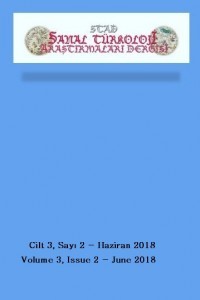HÜKÜMET PROGRAMLARINDA KULLANILAN YANTÜMCELERİN TARİHSEL SÖYLEM ÇÖZÜMLEMESİ
Söylem çözümlemesinin bir uzantısı olarak görülebilecek olan tarihsel söylem çözümlemesi geçmiş tarihsel dönemlerde dilsel yapıların geçirdiği değişiklikleri betimlemeyi hedeflemektedir. Bu çalışma tarihsel söylem çözümlemesi yaklaşımını benimseyerek 1923-1949 yılları arasında yayınlanan hükümet programlarında yer verilen yantümceleri (ortaçlar, çok işlevli belirteç yantümceleri ve tümleç yantümceleri) nicel ve nitel açıdan betimlemeyi ve sözkonusu dönemde yantümce kullanımı bakımından değişiklik meydana gelip gelmediğini ortaya koymayı amaçlamaktadır. Çalışma ayrıca daha önce incelenmiş olan 1950-1999 tarihleri arasında yayınlanan otuz yedi hükümeti programında kullanılan yantümcelerle kullanılan yantümce türleri bakımından bir karşılaştırma yapılmasını da hedeflemektedir. Türkiye Büyük Millet Meclisi’nin wen sayfasından ulaşılan 1923-1949 döneminde yayınlanmış olan onsekiz hükümet programındaki yantümceler belirlenerek türlerine ayrılmış ve bunların sıklık değerleriyle yüzdeleri elde edilmiştir. Ardından yantümce türlerinde kullanılan ekler belirlenerek sıklık ve yüzdeleri hesaplanmıştır. Çalışmada ulaşılan bulgular incelenen onsekiz hükümet programında en fazla ortaç yantümcelerinin kullanıldığını, bunu sırasıyla belirteç yantümceleri ile tümleç yantümcelerinin izlediğini göstermektedir. Belli dilsel amaçlarla kullanılan yantümcelerin metinlerin bilgisellik değerinin artırdığı ve dile getirilen ad öbeklerinin ve eylemlerin yantümceler yoluyla ayrıntılandırıldığı saptanmıştır. 1950-1999 tarihleri arasında yayınlanan otuz yedi hükümeti programında kullanılan yantümce türleriyle yapılan karşılaştırma ise ortaçların her dönemde en sık kullanılan yantümce türü olduğunu ortaya çıkarmıştır. İkinci sırada ise belirteç yantümceleri yer almakla birlikte bir dönemde, 1950-1960 dönemi, belirteç yantümceleri en az kullanılan yantümce türü olarak bulunmuştur. Tümleç yantümceleri ise diğer iki yantümce türüne ele alınan tarihsel dönemlerin biri hariç tümünde en az kullanılan yantümce türüdür. Çalışmanın sonuçları hükümet programlarının bazı farklılıklarla birlikte kendine özgü bir örüntüye sahip olduğunu ve bir dil kesiti olarak ayırt edici özellikler barındırdığını göstermektedir.Anahtar sözcükler: söylem çözümlemesi, tarihsel söylem çözümlemesi, yantümceler, resmi söylem, ortaçlar, çok işlevli belirteç yantümceleri, tümleç yantümceleri
Anahtar Kelimeler:
Söylem çözümlemesi, tarihsel söylem çözümlemesi, yantümceler, resmi söylem, ortaçlar, çok işlevli belirteç yantümceleri, tümleç yantümceleri
Historical discourse analysis, which can be regarded as part of discourse analysis, aims at describing the potential changes observed in linguistic structures used in texts over time. The aims of this study are to describe embedded clauses (namely, relative clauses, adverbial clauses, complement clauses) used in the government programs published in the period of 1923-1949 in terms of their distribution and the suffixes used and to reveal the changes over their use and structures following a historical discourse analysis approach. In addition, the study aims at making a comparison between thirty-seven goverment programs produced between 1950 and 1999 and those published in the period of 1923-1949 based on embedded clauses. The corpus of the study includes a total of eighteen goverment programs, which were taken from the website of Turkish National Assembly. First the embedded clauses used were identified and they were classified depending on the embedded clause type. Their distribution and percentage based on these types were determined. Then, the suffixes used in each embedded clause type were identfied and their frequency and percentage were found. The findings of the study indicate that it is the relative clauses, which have the highest percentage among three embedded clause types. It is followed by multifunctional adverbial clauses and complement clauses. These embedded clauses are used for certain goals in the texts and they are mostly used to expand the informative feature of the goverment programs. The other major function of these embedded clauses is to make both noun phrases and verb phrases much more detailed. The comparison of the government programs from different periods showed that relative clauses are the most frequently used type of embedded clauses. It is followed by adverbial clauses except for one period, 1950-1960. Complement clauses less used in contrast to other two embedded clause types. Based on these findings it can be stated that government programs have unique and distinctive textual features
Keywords:
Discourse analysis, historical discourse analysis, embedded clauses, official discourse, relative clauses, multifunctional adverbial clauses, complement clauses,
- ISSN: 1301-9155
- Yayın Aralığı: Yılda 2 Sayı
- Başlangıç: 1996
- Yayıncı: Şükrü Haluk AKALIN
